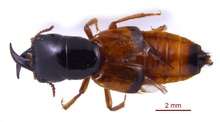Oxyporinae
The Oxyporinae are a subfamily of the Staphylinidae discovered in 1839 by Erichson.[1] One genus, Oxyporus Fabricius, with six species, is found in North America.
| Oxyporinae | |
|---|---|
 | |
| Oxyporus mexicanus | |
| Scientific classification | |
| Kingdom: | |
| Phylum: | |
| Class: | |
| Order: | |
| Suborder: | |
| Infraorder: | |
| Superfamily: | |
| Family: | |
| Subfamily: | Oxyporinae Erichson, 1839 |
| Genera and species | |
| |
Anatomy
All Oxyporinae have prominent mandibles. Their apical labial palpomeres are very large and strongly securiform. Their tarsi, like most Staphylinidae, are 5-5-5.
 Oxyporus mexicanus
Oxyporus mexicanus Oxyporus mexicanus
Oxyporus mexicanus Oxyporus femoralis
Oxyporus femoralis
Ecology
Most Oxyporinae are fungivores. Their whole lifecycle involves fungi, as females construct egg-laying chambers in fungi and reproduce in them. Thus, most scientists inspect mushrooms and fleshy fungi to find these creatures.
gollark: H: and D: look big enough.
gollark: Basically every modern computer has more than enough.
gollark: How little do you *have*?
gollark: Maybe try a better OS next time.
gollark: <@!111569489971159040> Use the WSL?
References
- Newton, A. F., Jr., M. K. Thayer, J. S. Ashe, and D. S. Chandler. 2001. 22. Staphylinidae Latreille, 1802. p. 272–418. In: R. H. Arnett, Jr., and M. C. Thomas (eds.). American beetles, Volume 1. CRC Press; Boca Raton, FL. ix + 443 p.
This article is issued from Wikipedia. The text is licensed under Creative Commons - Attribution - Sharealike. Additional terms may apply for the media files.